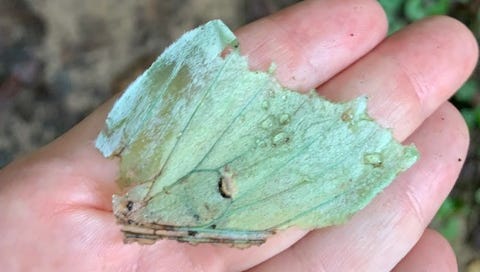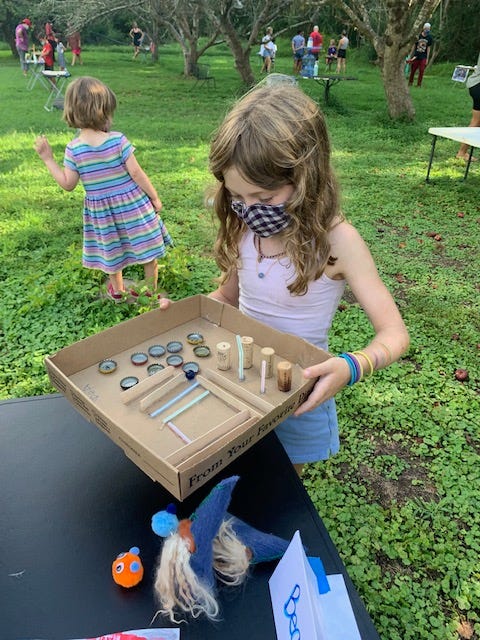This week was back-to-school for me—my first time teaching in person since March of 2020. I had a chance to meet our wonderful graduate students, who have come from as far away as India and as close-by as Durham, as well as the delightful undergraduates in my two creative writing classes. I’m also auditing a terrific class in sociolinguistics and public science, conveniently located in the exact classroom where I teach on Tuesdays and Thursdays.
All good things, as Olaf says. Except…
My university does not have a vaccine mandate, though the Supreme Court seems to say that we could. Our vaccination rate is low. Masks are required in every indoor space, but I don’t know how recently the ventilation system was updated, and the windows in my classrooms and my office don’t open. They’re not stuck or broken, but were sealed shut years ago to save energy. The classrooms are small, and we’re elbow-to-elbow in there.
Professors were asked to take photos of our rooms on the first day of class, and to ask students to keep the same seats for the semester. This is to make contact tracing easier, when students inevitably get sick with COVID-19, and anyone within a 6-foot radius will be asked to test and quarantine. I tried this in my first class, backing all the way into the corner, but I couldn’t get everyone at once; we were too packed. For group discussion I sent the students outside.
I am also keeping a count of the number of times I need to ask people to mask up in the hallways. On Thursday I spoke to four students, and one on-campus worker, who were not wearing masks or were wearing their marks incorrectly, with their noses or whole faces exposed. I didn’t speak to every non-compliant person I saw—sometimes I second-guessed myself (surely he’ll pull that mask up any second), and by the end of the day I was tired of the rolled eyeballs.
I get it—masks are uncomfortable, especially if you’re wearing them all day, class after class, or if you’re in a three-hour seminar. I am thirsty all day long, and aware of my body in a way I haven’t been since I was a nursing mom and had to take breaks to pump, pulling down my blinds and locking the door. But they’re also necessary for preventing the spread of a highly contagious, deadly virus.
I don’t place blame with the students. The university does not appear, in my estimation, to be adequately committed to our safety. Signage in my building is minimal. Consequences for noncompliance are unclear. Unlike other universities, we have not offered vaccination incentives, though I can think of many good ones (free parking passes! gift certificates to the bookstore and on-campus dining!). Not every professor is choosing to correct people in the hallways (it is a choice, we have been told, rather than a shared responsibility). It’s awkward, for sure (and I have to wonder how much of this work is falling to women).
“We have vaccines,” the administrators say. Well, yes—I’m vaccinated. But I have no idea how many students in my class are (I’m not allowed to ask). And Beatrice and Harriet, at seven and three years old, are not vaccinated. Some of my students have younger siblings, or their own young children at home, and they are worried too. It may be months before vaccines for young children will be approved.
I have not yet heard an administrator make reference to faculty and students with family members who are twelve and under, and therefore ineligible for Covid-19 vaccines. Nor have I heard a single reference to the “cocoon” strategy of creating a barrier of safe adults around unvaccinated children—we should all be vaccinated, masked indoors, and socially distanced. Child hospitalizations are rising at an alarming rate, with more than 1,200 children filling hospital beds across the country. Even before the Delta variant, some children became very ill with Covid-19; a seven-year-old friend of ours, diagnosed in October 2020, was sick with a fever for a month.
In North Carolina, the two fastest-rising demographics with positive COVID-19 cases are children and young adults. People the age of my kids, and people the age of my students. Yet young people appear to be invisible, or maybe just unimportant, to many decision-makers.
“The fundamental goal of the adults in any society is to protect their young and do everything they can to leave a better world than the one they inherited,” wrote activists Greta Thunberg, Adriana Calderón, Farzana Faruk Jhumu and Eric Njuguna in the New York Times this week. “The current generation of adults, and those that came before, are failing at a global scale.”
They were writing, of course, about the climate crisis. As the authors point out, children are at a higher risk than adults for health complications related to climate change, and there are currently one billion children (nearly half of the kids on Earth) living in countries at “extremely high risk for climate and environmental hazards, shocks, and stresses.” Adults of my generation and older have had the opportunity to take serious steps to mitigate climate change, and we have failed to act.
I can’t help connecting COVID-19 and the climate crisis—and with a sinking, defeated feeling. COVID-19 is, comparatively, so much easier to mitigate. We know what works: require vaccines, require masks, ensure social distancing, and ventilate your spaces. In their damning assessment of a catastrophic failure to protect the young, Thunberg, Calderón, Jhumu and Njuguna may well have been writing about the anti-mask and anti-vaccine stances of Ron DeSantis, Greg Abbott, or any number of people who have chosen to put politics over safety and science. They may well have been talking about the decision-makers at my school, who don’t share the politics or ignorance of DeSantis and Abbott, but who act in fear of our anti-science, anti-safety, anti-public health Republican legislature.
On Friday I did not go to a student-faculty reception that was being held partially indoors, which was a hard choice for me to make. I went instead to the Friday share at Clapping Hands Farm, Bea’s all-outdoors summer camp—I did marble mazes, saw her gnome show, and admired the arts and crafts the kids had worked on all week. This camp was free for anyone who lives in Chatham County, and in general they have a “no one turned away” policy. The counselors are a diverse and lovely group, and even though we were outside and it was about ninety degrees, everyone wore their masks (except Harriet at times, who was being difficult). With small folding tables, the kids spaced out under an apple orchard to show off the work they were proud of.
It was a little burst of hope—in the ingenuity and willingness of people to put community and safety first. It was what I needed.
If you’d like to support Clapping Hands Farm’s scholarship fund, which offers free or low-cost camps that can inspire a love of nature, art, and humanity, click here:
https://www.gofundme.com/f/clapping-hands-farm-scholarship-fund-2021
And we’ll see you on Tuesday. Stay well, and let us know about any bursts of hope (or moments of despair) you’ve had this week in the comments below. We’d love to hear.






our turtle eggs were transferred to the Turtle Sanctuary so i am hoping they will hatch soon
I'd also be very uncomfortable teaching in those conditions. Where I teach in Canada (and this is the case for much of the province of Ontario) we have MANDATORY vaccinations + MANDATORY 6' SOCIAL DISTANCING + MANDATORY MASKING AT ALL TIMES. All three at all times. It might seem extreme but I do think all three cautionary measures are important when we have new variants like Delta and I'm grateful for them. Still, it's going to be hard to teach seminars when students are masked and separated by so much space and I wish, wish, wish more people would get vaccinated--both for their own sakes' and to stem the proliferation of new variants.